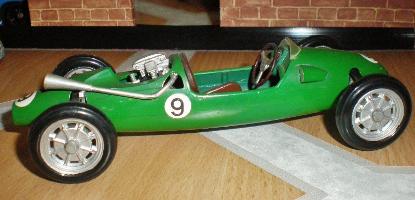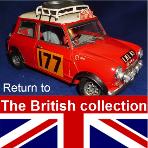
1956 Cooper MK9 history
Coopers Mk IX is the 1955/56 descendent of the neat little 500 cc racing car devised by Charles and John Cooper, Father and Son, at their family garage business at Surbiton, Surrey.
Through the years the cars steadily improved in performance and appearance, and several hundred formula 3 Coopers were constructed. Essentially simple, the design embodies a motorcycle type engine - twin O.H.C. Norton or push-rod O.H.V. J.A.P. - installed aft of the driver, in a ladder type frame of small diameter tubes. Power is transmitted by chains through a motorcycle type gearbox to the final drive. The rear brake is a single disc, mounted in-board and suspension is independent on all four wheels by single transverse leaf springs front and rear, and tubular wishbones. The Cooper 500 had an enviable reputation for tenacious road holding.
Stirling Moss, Peter Collins, Alan Brown, Stuart Lewis-Evans and numerous others raced coopers to victory in the past, even today's F1 impresario Bernie Ecclestone raced a 500cc Cooper.
The F3 cars became F2 cars and in 1958 an F2 Cooper, upgraded by the Rob Walker team and driven by Stirling Moss, won the Argentine F1 GP. This result was the death knell for front engined Grand Prix cars and in 1959 an F1 Cooper won the drivers championship for Jack Brabham as well as the constructors championship for the small Surbiton outfit.
Cooper stopped production of the 500cc cars in 1960 and concentrated on their Formula one ambitions.





1/24th scale kit.
Built by Rod.


The Merit kit of the Mk9 Cooper 500 was amongst the several contemporary racing car kits issued in the late 1950s and early '60s, most of which feature somewhere in our museum website. J & L Randall Ltd was a British toy manufacturer from Potters Bar, Hertfordshire. Merit was the company's brand for general plastic toys and it's plastic model kit range flourished in the 1950s and 1960s. Merit kits of aeroplanes and ships were also available and the company was heavily into plastic railway accessories. But the the racing cars range is now considered classic and highly sought after today. The range consisted of 14 cars from the 1940s and '50s, two of them (the Alfa 158 and the Talbot-Lago), were sold as 'superkits' and had engine detail.
All the kits are primitive by today's standards with limited detail, very thick plastic and very simple construction methods. However, Randall's did capture the essence of the cars, the lines and proportions are good and these kits provide an excellent base for a detailed model using today's modern paints, build methods and aftermarket detailing parts.
A French company called Sitaplex also released some of the Merit road and race cars in the 1960s. They were a contract moulding company and also released some Heller kits. Mostly remembered for ship and aircraft kits we know the company did release several of the race and road cars, the race cars in boxes similar to the Merit ones and the road cars in Airfix style bags and a red header quite different to the Merit sales material. The Lotus Eleven, Ferrari D50 and Rolls-Royce limo are the ones we know of for certain though there are sure to be others.
Rod built his model in the late 1950s and it is made with the tools of the time. That is to same tube cement holds it together and brush applied Humbrol enamel paints give the model colour. He was only just starting out in this hobby and Merit cars were the hook that got him started building model cars, well over 60 years later and he is still building.
RETURN TO :-
